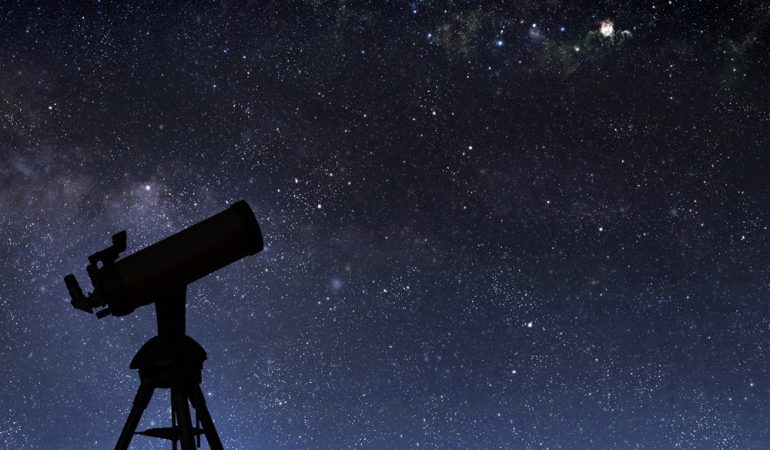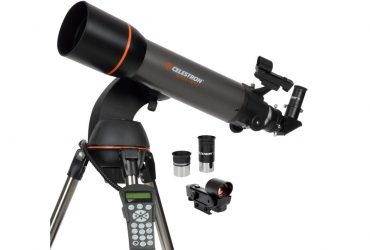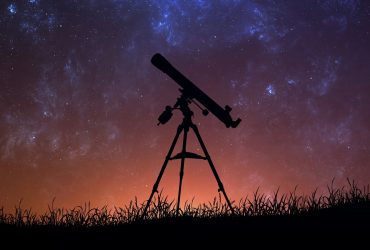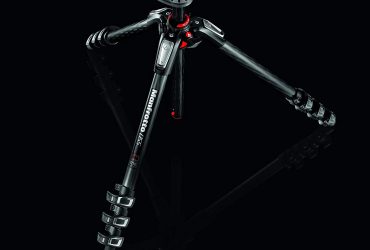The Best Telescope For Astrophotography: Reviews and Buyer’s Guide
With astrophotograhy, it’s all about having the right equipment in the right kind of setting. But trust me when I say that having the most expensive astro camera, tripod or laptop is no substitute for a bad view. Lucky for you, you’re in the best place you could possibly be if you really want the best telescope for astrophotography. Have a look at some of the highest ranked models in their categories in the UK:
1. Voted by experts as the best telescope for astrophotography for most people, the AP 80/480 Apochromatic Refractor from Explore Scientific guarantees solid construction and even better optics.
2. Also the instrument of choice in most professional observatories, the Ritchey-Chretien F/8 Optical Tube Assembly from Orion is the ideal telescope for astrophotographers looking to upgrade to the next best thing.
3. Looking for a helping hand before you leap head first in the confusing world of astrophotography, then the Orion Newtonian Astrograph is a safe, practical and budget friendly bet.
Astrophotography Telescope Buying Guide
Of all the numerous and equally appealing aspects of astronomy, astrophotography has to be at the very top of that list. And it’s no wonder; I mean, there’s nothing quite like having the ability to capture all the beauty, awe, and majesty of all that the cosmos have to offer. Observing is one thing, but astrophotography allows you to keep a lasting record of the deep skies and even share the breathtaking images with the world.
But to do that, you need to have the right equipment; and it all starts with the best telescope for the job. This segment will show you how to find a telescope that not only gives you as clear a view as possible, but also facilitates the photography of distant stars, nebulae, galaxies and other celestial bodies. So, how should a beginner go about selecting the perfect option for them?
Key Features and Considerations When Purchasing an Astrophotography Telescope
Let me start by saying that the factors that combine to make up a great telescope will depend on your needs, budget and a few personal considerations. However, there are some common features and aspects that beginners need to look out for.
i) Focal Length
Whether for general observation or for pure astrophotography, the focal length is such a crucial component when purchasing any telescope. The focal length simply refers to the distance between the primary lens to the light focus and it determines the scope’s magnification power and angular field of view as well. The shorter the focal length, the wider the field of view you can cover. The longer it is, the narrower the field and more magnification you can achieve.
ii) Aperture
The aperture determines the light gathering capabilities of your telescope. However, there is a misconception that you need to go as big as possible to get the best images. In truth, you could have a massive telescope with an even bigger aperture, but you’d get nothing but blurry images if the optics are not great quality. Make sure you match those two factors for vivid astrophotography.
iii) Mount
A telescope without a mount is nothing but an old fashioned one-eye binocular. Whether for astrophotography or general celestial viewing, your scope needs to rest on something solid and reliable. Mounts come in various designs such as an altazimuth that lets you manually move the scope. However, Equatorial mounts are perfect for astrophotography since they can track single, deep sky object al night long by accounting for Earth’s rotation.
Best Astrophotography Telescopes Reviewed
1. BEST FOR MOST: Explore Scientific AP 80/480 Apochromatic Refractor
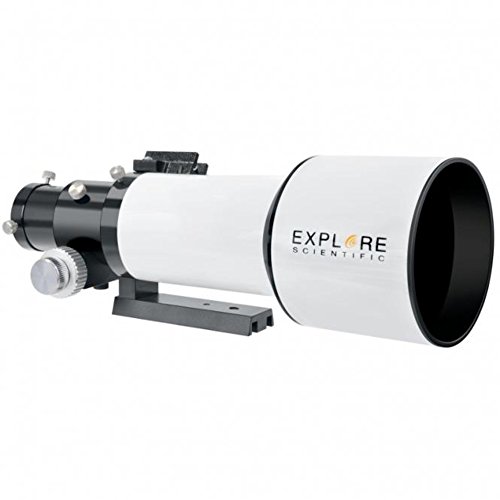
Pros
- Ideal grab and go scope for beginner astrophotographers
- Razor sharp optics with vibrant colouration
- Small, light and compact aluminium construction
Cons
- Poor tolerances on some of the machining, especially the mount
Overview
When it comes to small and medium sized scopes, Apochromats are hands down the ultimate choice. Their combination of portability, compactness, high image contrast and sharpness allow for some excellent astrophotos that are tough to best.
Voted by experts as the best overall telescope for astrophotography, the AP 80/480 Apochromatic Refractor from Explore Scientific is a favourite among both beginners and hobbyists as well.
This scope boasts of an 80mm aperture with a focal distance of 480mm. Thanks to the super fast f ratio, this telescope makes shorter exposure times possible. With great solid construction and even better optics, what more could you ask for?
What It Does Best
Being the best overall telescope for astrophotography, you can pretty much guess what it does best. This scope from Explore Scientific gives you some of the best images you’ve ever seen even before processing! One of the reasons is because the ultra light scope also features an air spaced triplet optical design and diffraction limited optics.
This clever design virtually eliminates all signs of chromatic aberration to deliver excellent, high contrast, razor sharp images with vibrant colours and vivid details. It is indeed quite unusual to see this feature at the given price range. However, all kudos go to Explore Scientific for giving us some pretty impressive optics and a whole lot more performance than we expected.
Flaws But Not Deal Breakers
You’ve got to hand it to the manufacturer; they really covered all the bases with this one. The Explore Scientific AP 80/480 Apochromatic Refractor telescope is almost perfect in every way. Technically speaking, there’s really nothing wrong with the telescope itself. However, there are just a few things that we feel could have been done better.
For starters, the mount attaches to the scope via a riser block and hex bolts. However, the spacing between the tube and tail is a bit small. This means that you can’t really push the scope that far forward on the mount and that the focuser can’t be rotated more than a few degrees in either direction. Likewise, you’ll need to keep tightening some of the hex bolts regularly so they don’t come completely lose.
What Other Customers Think
Looking at some customer reviews online, it’s clear that almost all people who purchase the Explore Scientific AP 80/480 Apochromatic Refractor for astrophotography got exactly what they were looking for.
Not only does everyone appreciate just how small, light and compact nature of the scope that allows it to be carried anywhere, but the fact that it has all the technology you need to get started is a big bonus. The high quality images produced are also something worth mentioning.
Should You Buy It?
The fact that you’re already looking at the Apochromatic telescope means that you’re definitely ready for it. This is a very fine instrument that not only delivers more performance than you expect, but it just might be one of the lightest leading scopes for taking astrophotos.
It’s this combination of portability, compactness, high image contrast and sharpness that allows for some excellent astrophotos that makes this bad boy the best overall telescope for astrophotography.
2. BEST UPGRADE: Orion 08267 Ritchey-Chretien F/8 Optical Tube
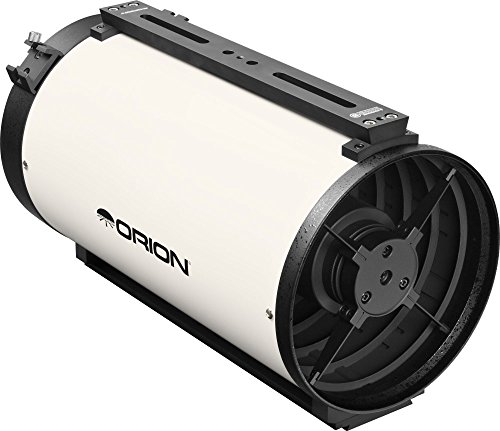
Pros
- Quality optics similar to professional observatory level
- Excellent construction and attention to detail
- Shoots flat, coma free astrophotos
Cons
- Some images may be affected by diffraction spikes
Overview
What do most professional observatories have in common? Simple, they use reflector telescopes most of the time. But not just any old reflector; the instrument of choice is usually the Ritchey-Chretien.
Invented early on in the last century by Frenchman Henry Chretien and astronomer George Willis there’s a reason why this design is so treasured by both beginner astronomers and the pros alike.
The Orion Tube Assembly produces great fields of view with coma free, non elongated objects. On top of that, the scope has actually been optimized for astrophotography with a wide range of cameras including CCDs, APCs and even DSLRs.
What It Does Best
One aspect that makes this telescope notable is the use of Hyperbolic primary and secondary low expansion quartz glass mirrors that grants a whopping 96% reflectivity. This allows for some of the brightest imaging performance and flat, coma free photos of the deep dark skies.
So as opposed to conventional reflector designs that are prone to coma outwards from the center field, the Ritchey-Chrétien optical tube from Orion utilizes its hyperbolic low-expansion quartz glass mirrors to achieve this coma free clarity.
And since there are no lenses, captured deep space images are absolutely free of chromatic aberrations for what I can truly say is true-color performance. As if that wasn’t enough the secondary mirror is precisely centre marked to give you a huge head start in terms of collimation.
Flaws But Not Deal Breakers
As sweet as Frenchman Henry Chretien and astronomer George Willis’s design for the Orion Optical tube may be, there are some tiny flaws. However, all those seem insignificant compared to the one weak spot that the telescope has.
Yeap, you guessed it; the field curvature. This results in objects and stars being just a bit out of focus, especially around the edge of the field of view. Still, this is a huge trade off compared to what you would get if you had coma to contend with.
So in a way, the tube assembly picks the lesser of two evils to give you as attractive an astrophoto as possible. But at its current focal length, there’s really no noticeable effect on the images taken.
What Other Customers Think
Straight out of the bat, it’s clear that the Orion 08267 Ritchey-Chretien F/8 Optical Tube Assembly delivers as much customer satisfaction as it does clear images.
Looking at what other customers had to say about it, it’s obvious that this scope grants users a major advantage over most Newtonians and even some Schmidt telescopes.
Similarly, most of the users seem to be serious astronomers looking to update to a more powerful astrophotography telescope. All in all, we can all agree that it’s a pretty effective model that does what it’s supposed to.
Should You Buy It?
Combining the highly regarded optical design of the Ritchey – Chretien with some of the most excellent light gathering capabilities, the Orion 08267 Ritchey-Chretien 8 inch is definitely worth all the attention it’s been getting.
Its compact, has great construction, incredible attention to detail and an incredibly assembly of mirrors. So if you’re after exceptionally perfect images of all the celestial wonders you can grab, then the Orion Optical tube might just the best upgrade option fro astrophotography you can get.
3. BEST BUDGET: Orion f/4 Newtonian Astrograph Reflector Telescope
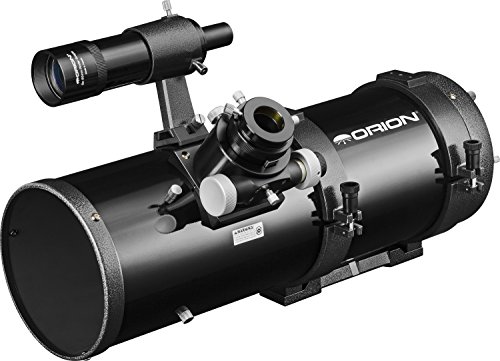
Pros
- Best budget telescope for astrophotography
- Fast performance with wide field of view
- Simple layout for beginners ease into
Cons
- Inaccurate components that add some difficulty to viewing
Overview
Whether you’re just beginning your astronomy journey or are already an experienced astrophotographer who knows his stuff, chances are that both these guys are using something from Orion. And the company have proved just this by releasing one of the best budget telescopes I’ve seen in a while.
If you’re looking for something both affordable and practical, then let me introduce the 6” Newtonian Astrograph telescope. This particular model may be cheap in some circles, but it offers some pretty decent and colour rich pictures of galaxies and bodies.
With an average 6 inch aperture and a quick f/4 focal ration, this bad boy is sure to impress, especially if you’ve never used one before.
What It Does Best
Apart from saving you a lot of money, there’s something else this scope excels at. The reason why the Newtonian Astrograph from Orion is great with beginners is because it teaches you how to use a scope as you go along.
You can tell straight from the packaging which is stress free and shows you what each piece is and what role it plays in the assembly. Not only is the layout of the scope perfect, but it’s also easy to find all the knobs, buttons and settings without getting too lost.
Sure, there might be a few more added features than we’re used to at the entry level, but that’s a good thing in the long run if you’re really thinking of taking astrophotography as a career.
Flaws But Not Deal Breakers
Most of us have already had some experience with Orion’s reflector scopes; that’s why it didn’t come as a surprise that the Orion f/4 Newtonian Astrograph Telescope is slightly low quality and average durability.
I’m not saying it will break on the first drop, but it can’t take a lot of manhandling like other refractors on this list. And just the slightest disturbance or rattle will throw the whole thing out of alignment leading to some frustrating stargazing.
What Other Customers Think
For a budget telescope, it’s quite amazing that previous customers had nothing but nice things to say about it. Some even went as far as saying that the tube was strong and sturdy and that the collimation was much easier to achieve.
But while everyone was satisfied with how the telescope works great with most cameras, there’s always some critics out there. Some customers weren’t too happy with the inaccuracy of the focus micro adjust knob or the length of the rail.
Should You Buy It?
It’s tough to argue with the lasting appeal of this telescope, even with it’s very low price range. Sure, it’s got a few shortcomings and uses pretty much outdated tech. But it does guarantee some very clear images on a dark night if you can get the assembly perfect. And that’s definitely something that many astrograph telescopes can claim to do, especially not at that price range.
So if you’re looking for a helping hand before you leap head first in the confusing world of astrophotography, then the Orion Newtonian Astrograph is a safe, practical and affordable bet.
Frequently Asked Questions
1. How to connect a DSLR to a telescope
The most common way to connect a DSLR to a telescope is using a T-ring and a prime focus adapter. Screw the T-ring onto the prime focus adapter. Remove any lenses on your DSLR and attach the prime focus adapter + T-ring assembly onto the camera.
Remove the diagonal or eyepiece holder from your telescope and insert the entire camera assembly (DSLR + prime focus adapter + T-ring) into the telescope. Tighten the telescope screws to hold the camera in place.
2. What is dithering in astrophotography?
Dithering is a technique for improving the signal to noise ratio in an image. In dithering, the telescope shifts just a little between exposures. This eliminates noticeable noise patterns and adds random noise to make certain features like nebulae stand out. Dithering also makes it easier to eliminate hot pixels when you stack the images in post-processing.
3. What is coma in astrophotography?
Coma or comatic aberration occurs when stars and objects at the edges of the frame appear blurry and develop a tail like that of a comet. You have clear and sharp objects at the centre of the image but a noticeable haziness develops towards the edges. Coma is caused by a defect of the telescope lens.
4. How to reduce noise in astrophotography?
If your camera has long exposure noise reduction, turn it on. It’ll take longer to take images but you’l be rewarded with clearer and sharper results. You can also reduce noise in post-processing using methods like stacking.
You can also try using a telescope with a wider aperture (more light coming in, less noise in final image) or try dithering to reduce the appearance of noise patterns.
